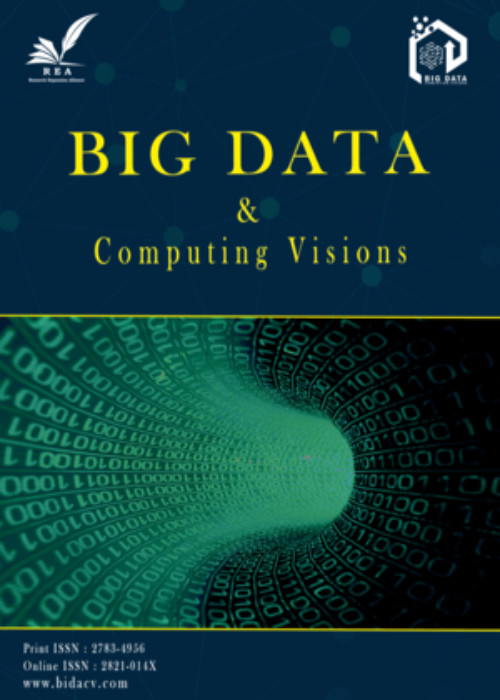فهرست مطالب
Big Data Analysis and Computing Visions
Volume:2 Issue: 1, Mar 2022
- تاریخ انتشار: 1400/12/10
- تعداد عناوین: 6
-
Pages 1-8This project is concerned with using a digital rather than a manual approach to providing bus passes. The major goal of this technology is to digitally manufacture bus passes and eliminate the need for handwritten paperwork. Commuters will be able to acquire their passes in a fraction of a second, eliminating the need to wait in lines. It will also make it easier for customers to pay for their passes online. As the project grows in size, all of the data will be transferred to the cloud. As we advance toward a smart bus pass generation system, the trouble of keeping change in pockets will soon be a thing of the past. The online-based bus pass generation and payment system will not only be a step toward a paperless green city approach, but it will also be a tremendous relief for daily commuters, saving them time and eliminating the daily bother of waiting in lengthy, tiring lines for their passes. Not to mention our senior citizens and female commuters.Keywords: digital, Smart pass, Android, Bus e-pass
-
Pages 9-17Analysis of big data has been presented as an advanced analytical technology involving large-scale and complex applications. In this paper, we review the general background of big data, and focus on data generation and data analysis. Then, we examine the several representative applications of big data, including enterprise management, Internet of Things, online social networks. These discussions aim to provide a comprehensive overview to readers of this exciting area.Keywords: big data application, Data Analysis, text analysis, web analysis, multimedia analysis
-
Pages 18-30
Coronary artery heart failure is the leading cause of mortality among other cardiac diseases. In most of the cases, angiography is a reliable method for the diagnosis and treatment of cardiovascular diseases. However, it is a costly approach associated with various complications. The significant increase in the prevalence of cardiovascular diseases and the subsequent complications and treatment costs have urged researchers to plan for the better examination, prevention, early detection, and effective treatment of these conditions. The present study aimed to determine the patterns of cardiovascular diseases using integrated classification techniques for analyzing the data of internal medicine patients who are at the risk of heart failure with 451 samples and 13 characteristics. Selecting characteristics and evaluating the influential factors are essential to the development of classifiers and increasing their accuracy. Therefore, we investigated the influential factors of the Gini index. In the classification phase, basic techniques were used, including a decision tree, a neural network, and different cumulative techniques such as gradient boosting, random forest, and the novel deep learning method. A comparison revealed that deep learning with the accuracy of 95.33%, disease class accuracy of 95.77%, and health class accuracy of 94.74% could enhance the presentation and results of the neural network. Out findings confirmed that cumulative methods and selecting influential factors are essential to increasing the accuracy of the diagnostic systems for heart failure. Furthermore, the reported practical tree rules emphasized the use of analytical methods to extract knowledge.
Keywords: Data Analysis, Diagnosis of Heart Failure, Cumulative Algorithms, Deep Learning -
Pages 31-39Drilling is among the major processes of exploration, description, and development of oil and gas reservoirs with a strategic significance in the oil industry. It has also always been a major challenge in the oil industry. Because of the importance of drilling in major upstream oil and gas industries, identifying related risks is also of great importance. Risk assessment systems are tools for identifying potential risks and assessing their levels, which have been widely used in various industries and disciplines in recent years. Accordingly, this study identified and assessed major environmental risks caused by onshore and offshore drilling operations and presented an approach to reduce their risk levels. Offshore and onshore risks were identified after identifying the drilling operation of oil wells. Indexes used in the FMEA method were selected to determine the most significant risks. The identified risks were then ranked by experts and entered the TOPSIS decision matrix as a useful technique to prioritize and select the most significant and most effective risks. Shannon's Entropy was used to weight identified indexes. Finally, 33 environmental risks resulting from oil well drilling operations in onshore and offshore ecosystems were identified. Corrective measures were presented for each environment to reduce the level of identified risks and their effect on the environment.Keywords: Oil, gas well drilling, Environmental risk assessment, Failure Mode, Effects Analysis, Technique for order of preference by similarity to ideal solution, Shannon Entropy
-
Pages 40-48Household object detection is a brand-new computer technique that combines image processing and computer vision to recognise objects in the home. All objects stored in the kitchen, room, and other areas will be detected by the camera. Low-end device techniques for detecting people in video or images are known as object detection. With picture and video analysis, we've lost our way.Keywords: object detection model, Neural Network, Deep Learning, Python
-
Pages 49-60The purpose of this research was to empirically examine the effect of independence, size, expertise, and gender of the audit committee on audit report lag in firms listed on the Tehran Stock Exchange (TSE). Using unique data from Iran for a 5-year period between 2016 and 2020, the results showed that financial expertise and independence of the audit committee have a significant negative effect on audit report lag. This suggests that more experts and non-executive members on the audit committee minimize audit report lag and reduce the timeliness constraint that dominates the qualitative characteristics financial information. The results also showed the significant positive effect of audit committee gender on audit report lag, while there was no significant relationship between the size of the audit committee and audit report lag, indicating that the quality of the audit committee is more important than its quantity.Keywords: Audit Committee, Audit Report Lag, Timeliness, Information Disclosure


